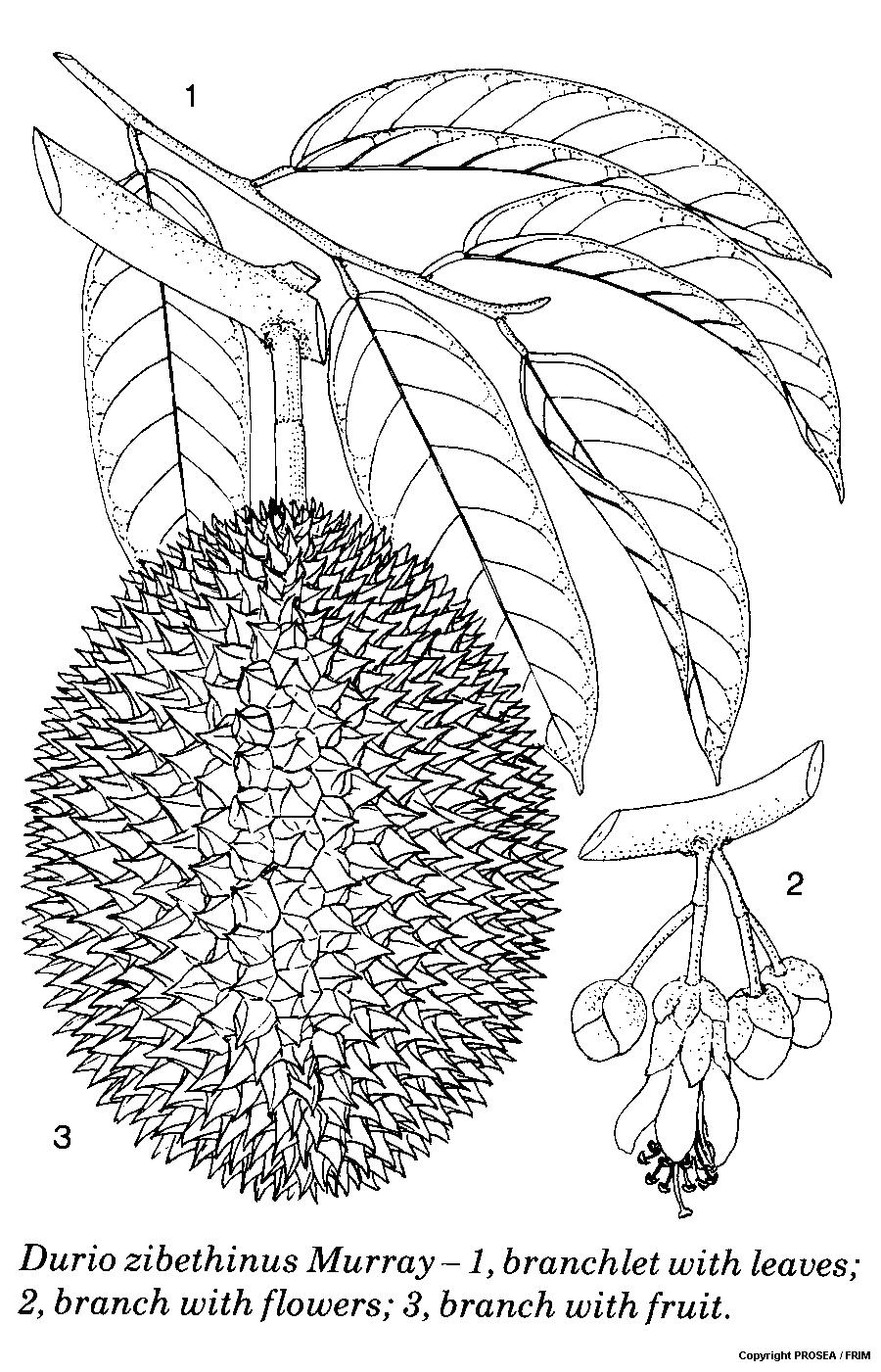Durio zibethinus Murray
Family
Bombacaceae
Synonyms
Durio acuminatissima Merr.
Vernacular Names
| General name in all languages | Durian. |
| Indonesia | Duren, ambetan (Javanese), kadu (Sundanese). |
| Philippines | Dulian (Sulu). |
| Burma (Myanmar | Du-yin. |
| Cambodia | Thu-réén. |
| Laos | Thourièn. |
| Thailand | Thurian (General), rian (Southern Peninsula). |
| Vietnam | Sâù-riêng. |
Geographical Distributions
The genus of Durio zibethinus is native to Southeast Asia and its wild trees are found in Borneo and Sumatra. In cultivation, the tree has been spread over areas ranging from Sri Lanka and South India to Papua New Guinea. Only a few trees are found outside these area, namely in Australia, Hawaii and Zanzibar. D. zibethinus is quite common throughout Southeast Asia, but in the Philippines only in Mindanao, while in the rest of the country, the trees are few and far between. It is also an important crop in Vietnam and Burma. The trees are mainly grown in home gardens and on field borders, where they belong to the upper storey of a rich mixture of trees. In Thailand, it is largely grown in orchards.
Description
D. zibethinus is a large and buttressed tree that grows in conformity with Roux’s architectural model and can reach up to 40 m tall. The bark is dark red-brown, peeling off irregularly and with dark red heartwood.
The leaves are arranged alternately, elliptical to lance-shaped, measuring 10-15(-17) cm x 3-4.5(-12.5) cm, chartaceous, acute or obtuse at the base and slenderly acuminate at the apex. The upper surface is hairless, glossy and densely reticulate. The lower surface is densely covered with silvery or golden coloured scales and with a layer of stellate hairs underneath.
The inflorescences are on the older branches that form fascicles of corymbs of 3-30 flowers and measure up to 15 cm long. The pedicel is 5-7 cm long. The flower buds are spherical-ovoid and measuring 2 cm in diametre. The epicalyx is split into 2-3 ovate, concave and with deciduous lobes of 1.5 cm length.
The flower is 5-6 cm long, measuring 2 cm in diametre and whitish or greenish-white. The sepal is tubular, measures 3 cm long and with 5-6 triangular teeth. There are 5 petals, spathulate, about twice as long as the sepal and they are narrowed into a conspicuous claw at the base. The stamens are numerous that unite in 5 free bundles. The style is pubescent while the stigma is capitellate.
The fruit is a spherical, ovoid or ellipsoid capsule, measures up to 25 cm long and measuring 20 cm in diametre. It is green to brownish, covered with numerous broadly pyramidal, sharp and with the spines measure up to 1 cm long. There are usually 5 valves, thick and fibrous.
The seeds are up to 4 cm long, completely covered by a white or yellowish, soft and very sweet aril.
Ecology / Cultivation
D. zibethinus is strictly tropical. It is grown successfully up to 800 m elevation near the equator, and up to latitude of 18° from the equator in Thailand and Queensland. At these extreme latitudes, extension growth comes to a halt during the coolest months (mean temperatures below 22°C), but flowering and fruiting appear to be more prolific than in the non-seasonal climates. A well distributed rainfall of 1500 mm or more is needed, but relatively dry spells stimulate and synchronise flowering. If there is a prominent dry season, as in Chantaburi, the major D. zibethinus production centre in Thailand, a dependable irrigation system is essential. The soil should be deep, well-drained and light, rather than heavy to limit tree losses from a root rot. A sheltered site is desirable to prevent branches laden with fruit from breaking in gusty winds.
Line Drawing / Photograph

References
- Plant Resources of South-East Asia No. 2: Edible fruits and nuts.


